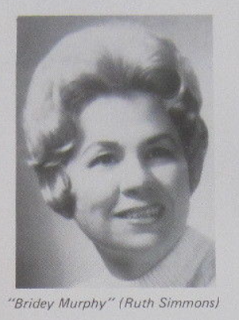On the Bridey Trail
Between November 1952 and October 1953, Virginia Tighe (aka Ruth Simmons), a Chicago woman who had never left the US, intrigued the world with her tales of her past life as Bridey Murphy, a nineteenth century Irish woman who had never left Ireland.
 |
| Photo by Morey Bernstein |
With the aid of amateur hypnotist Morey Bernstein, Tighe recalled specific names, places and events from her “life” in Ireland - things that could be checked. And following the release of Bernstein’s book on the affair, Denver Post reporter W J Barker came to Ireland to look for clues.
The following appeared in the Belfast News-Letter of 13 February 1956.
“DEAD” WOMAN SAYS HUSBAND WROTE FOR “NEWS-LETTER”
100-year-old files may provide clue in “reincarnation” mystery
Files of the “Belfast News-Letter” of more than a century ago may provide a link in the life story of a mysterious woman, Bridie Murphy, who has suddenly achieved world fame 90 years after her death in Belfast.
Her story has been fascinating Americans for the past 16 months, and at the moment is rivalling even Davy Crockett in popularity.
People all over the United States today are asking “Did Bridie Murphy ever really exist?” It is to try to find a concrete answer to that question that the American newspaper man who first introduced her to the public, Mr. W. J. Barker, of the “Denver Post,” has now come to Belfast. He spent most of yesterday visiting city cemeteries and examining old burial records in an effort to trace Bridie Murphy’s grave.
Hypnotist’s Subject
Her intriguing story began about two years ago when an amateur hypnotist, Mr. Moray Bernstein, began using a young housewife, Mrs. Ruth Simmons, from Pueblo (near Denver, Colorado) as a subject. Mrs. Simmons, while in a trance, began to describe a previous existence in which, she said, she was Bridie Murphy, born in Cork in 1798. In a changed voice, with a marked Irish accent, she then went on to tell how she had married Sean Brian Joseph McCarthy in 1818 and had gone to live in Belfast.
Her husband, she said, lectured in law at Queen’s College, and wrote articles in the “Belfast News-Letter.”
Tape recordings were made of a series of Mrs. Simmons’s hypnotic trances and transcripts of the conversations are included in a book “In Search of Bridie Murphy,” written by Mr. Bernstein and recently published in America. It is to be published in England next year.
Early trance
The first reference to the “Belfast News-Letter” came in an early trance when Mr. Bernstein asked his subject if there would be any records to prove that she had lived in Ireland at the time she said.
“There would be articles in the ‘Belfast Newsletter’ - about Brian,” was the reply.
Referring to her husband again at a later interview, she said: “He wrote for the ‘News-Letter’ … Brian had several articles in the ‘Belfast News-Letter’ … about law cases.”
“Did he ever sign his name to them?” she was asked.
“Oh, I’m sure he would.”
“Did you read any of them?”
“Oh, they were above me.”
“Did you read the ‘Belfast News-Letter?”
“Oh, a bit.”
Reacted to one
Mr. Bernstein, the hypnotist, later went to the Congressional Library in Washington and was there shown a copy of the “Belfast News-Letter” dated 1847. From it he made out a list of names of people and business firms in Belfast. At a later trance he asked the subject if she recognised any of these, but she reacted to only one - a reference to John Law’s Timber Yard, 13, James Street.
She then volunteered the information that there was in Belfast “a big tobacco company and a big rope company.”
Other information given during the trances included the fact that Bridie Murphy died in 1864 and that her tombstone bears the words “Bridget Kathleen M. McCarthy, 1798 - 1864.” Two of her friends, Mary Catherine and Kevin Moore, are also mentioned; a visit to the Glens of Antrim, including an amazingly accurate description of the journey along the Antrim Coast road, is referred to, and two shops in Belfast where she bought foodstuffs - one owned by a Mr. Farr and the other by a John Carrigan - are mentioned.
Records in the Belfast Public Library show that there was in fact a grocer named Carrigan in business at 90, Northumberland Street at that time, and that there was also a grocer named Farr in business at 59 - 61, Mustard Street, between Donegall Street and North Street.
It is because of the tremendous public interest which has been aroused in America by the publication of Mr. Bernstein’s book and by the tape recordings - which are being sold on a large scale in the U.S. - that Mr. Barker has come to Ireland to check these and other pieces of information. He has already been to Cork, where he has found that there was a Barrister named McCarthy in practice (as Bridie Murphy’s father-in-law was said to be) about the 1820s, and to Dublin. There he has been consulting the Irish Folklore Commission on the meaning of some dialect words used during the interviews, and which mean nothing to Americans.
Source:
Belfast News-Letter, 13 February 1956

Comments
Post a Comment